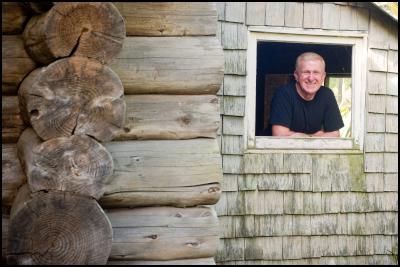Refitted Log Cabin to Promote Sustainable Building
Media Release
Refitted Log Cabin to Promote Sustainable Building
Mazin
Bahho – promoting sustainable building. Photo: Kevin
Bridle.
On a shady hillside behind EIT, a
derelict log cabin is being offered a new vocation as a
model for sustainable building.
Mazin Bahho, a senior lecturer in design at EIT’s ideaschool, says the project is the first of its kind in this country.
“There are many other sustainable buildings in New Zealand,” the Iraq-trained architect points out, “but they are not for demonstration purposes.”
The project has attracted considerable support through sponsorships from local organisations and businesses, as well as the backing of the trades and technology programmes at EIT.
Mazin has initiated the project as research for a thesis towards the PhD in Architecture he is undertaking through Victoria University. Once it is completed, the renovated cabin will be made available to school and community groups as a venue for workshops on sustainable building.
Groundworks recently started on a greenhouse addition, where native seedlings, potted up by visiting groups, will be nurtured. When the groups return some months later, they will be invited to plant a young tree on the surrounding slopes for each one they take away.
“We are aiming to return the area to native bush,” Mazin says of the Otatara hill site, which is culturally and historically significant to local Maori.
The log cabin also has past associations with EIT. Built in 1985 when Para Matchitt and Jacob Scott established the institute’s visual arts and design programme, the cabin was once used as teaching studio space and later for an artist in residence.
Clad in rustic douglas fir logs, the building’s walls are to be made airtight, insulated and lined and the windows double-glazed.
Rainwater will be channelled from the roof into a storage tank to use for cooking, washing clothes and showers and kitchen and bathroom wastewater is to be treated on site to nourish plants in the green house.
Solar panels on the greenhouse roof will heat water and generate electricity for use in the log cabin.
“The aim is zero net energy,” says Mazin, “so although the building will remain connected to the grid, it will generate more energy than it draws off.”
A concrete floor in the greenhouse will act as a passive solar store, helping to heat the log cabin. As much as possible, recycled materials are to be used in the refit.
Other buildings on EIT’s Otatara site were demolished some years ago, and ideaschool’s visual arts and design department is well-established on the campus below the hillside.
Plans for refitting the cabin, drawn up by students, will give it a new lease of life as a showcase, demonstrating the pluses of environmentally-friendly building design practices and technologies.
“It will serve as an educational tool and catalyst to inspire sustainable behaviour.” Mazin says, “utilising solar energy, thermal insulation, water conservation, managing wastewater, recycling materials and sustainable landscaping.”
Follow progress on the cabin’s refit on http://www.eit.ac.nz/2013/a-demonstration-sustainable-building-at-otatara/
ENDS



 Hospice NZ: Hospices At Risk Of Disappearing
Hospice NZ: Hospices At Risk Of Disappearing Health Coalition Aotearoa: New Bill A Vital Step Towards Tobacco-Free Future In Aotearoa
Health Coalition Aotearoa: New Bill A Vital Step Towards Tobacco-Free Future In Aotearoa National Youth Theatre: 140 Christchurch Kids Shine In National Youth Theatre’s Historic CATS Premiere
National Youth Theatre: 140 Christchurch Kids Shine In National Youth Theatre’s Historic CATS Premiere NZ Symphony Orchestra: NZSO To Tour Masterworks By Mozart, Beethoven, Haydn And More
NZ Symphony Orchestra: NZSO To Tour Masterworks By Mozart, Beethoven, Haydn And More Journal Of Public Health: Vape Shops Cluster Around Schools
Journal Of Public Health: Vape Shops Cluster Around Schools Timaru District Council: Aigantighe Art Gallery Hosts An Iconic Robin White Touring Exhibition
Timaru District Council: Aigantighe Art Gallery Hosts An Iconic Robin White Touring Exhibition